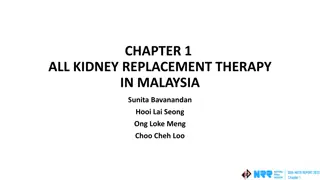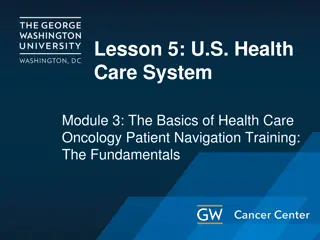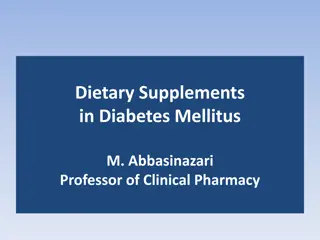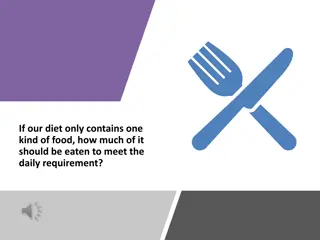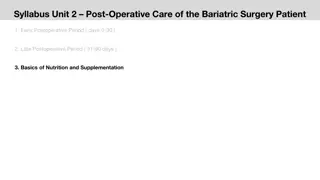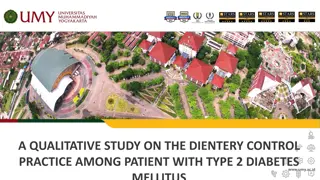Dietary Restrictions in Neutropenic Oncology Patients
The project explores the impact of restricting fresh fruits and vegetables intake on cancer patients undergoing myelosuppressive chemotherapy. Despite common practice, evidence supporting dietary restrictions is lacking. The study aims to determine if such restrictions truly prevent infections and improve patient outcomes. The findings highlight the need for further research to define the effectiveness of neutropenic diets in preventing infections.
Download Presentation

Please find below an Image/Link to download the presentation.
The content on the website is provided AS IS for your information and personal use only. It may not be sold, licensed, or shared on other websites without obtaining consent from the author.If you encounter any issues during the download, it is possible that the publisher has removed the file from their server.
You are allowed to download the files provided on this website for personal or commercial use, subject to the condition that they are used lawfully. All files are the property of their respective owners.
The content on the website is provided AS IS for your information and personal use only. It may not be sold, licensed, or shared on other websites without obtaining consent from the author.
E N D
Presentation Transcript
Implementation: Piloting the Change in Practice Marita G. Titler, PhD, RN, FAAN Rhetaugh Dumas Endowed Chair Department Chair, Systems. Populations and Leadership University of Michigan School of Nursing
Dietary Restrictions for Neutropenic Oncology Patients Project Director Linda Moeller, RN, BSN Team Deb Bohlken, RN, BSN, OCN Laura Suchanek, RN, MA, AOCN Linda Abbott, RN, MSN, AOCN
Purpose and Rationale To determine the evidence for restricting patient s intake of fresh fruits and vegetables to prevent infection Restricted food choices for cancer patients impact their quality of life, performance status and treatment outcomes
Synthesis of Evidence Myelosuppressive chemotherapy is the gold standard for treating oncology patients Neutropenia is an anticipated consequence of this treatment Neutropenia precautions are often implemented to protect patients
Synthesis of Evidence One component of neutropenic precautions has been restriction of patient s intake of fresh fruits and vegetables. Diet can not be directly linked to blood stream infections. Safe food handling and preparation are more likely to reduce food-borne infection than restrictions of fresh fruits and vegetables.
Diet Although dietary restrictions for neutropenic patients with cancer have been common practice, research and evidence to support the effectiveness of the practice are surprisingly lacking. Despite the lack of evidence to demonstrate decreased risk of infection with dietary restrictions, nearly all institutions recommend dietary restrictions to their patients. The most common recommendation is to avoid uncooked meats, seafood, and eggs and unwashed fruits and vegetables (Larson & Nirenberg, 2004; Moody, Charlson, & Finlay, 2002; Smith & Besser, 2000; Somerville, 1986; Wilson, 2002). Many of the studies relating to diet are complicated by confounding institutional manipulations, such as protected environments and differences in restrictions, that may have an impact. Inconsistencies in the literature and practice illustrate the need for further research to define the role and effectiveness of the neutropenic diet in preventing infection.
Practice Change Elimination of fresh fruit and vegetable restriction, with restriction of only select foods (unpasteurized food/beverages, blue veined cheeses) Education of patients and families about safe food handling and preparation Patient education brochure Modification of neutropenia precautions policy
Evaluation No change in blood stream infection rates before and after the practice change
Impact Decrease in stress and anxiety Improved knowledge about transfer process Increased understanding of differences in care on general units versus PICU. Expectations of general care unit.
Importance of Piloting the Practice Change By piloting on a limited basis (e.g. unit, patient population, time, etc) the scale is smaller Provides an opportunity for more focused implementation Effective use of resources Easier to attend to unexpected consequences
Piloting the Change 1. Select outcomes to be achieved 2. Write the EBP recommendations convert to practice standard, policy, procedure 3. Select measures (both process & outcome) to evaluate 4. Collect baseline data 5. *Implement EBPs on pilot unit(s) 6. Evaluate process and outcomes 7. Modify the EB practice guideline *Complex step
Example: NG Placement Procedural Changes Using auscultation is not reliable method to check placement of NG tubes (Methney et al) pH and color of aspirate used as primary bedside measure for determining NG/NI placement 30 cc of air insufflated prior to aspiration when small-bore catheters used Continuous feedings stopped for 1 hour prior to checking pH/color pH not used if patient receiving antacids
Indicators of Tube Location Esophageal placement belching immediately after insufflation with saliva appearing aspirate. Stomach placement pH of 1-4 (1-5.5 if patient receiving H2 receptor antagonist) with clear, light yellow, or light green aspirate. Duodenal placement pH > 6 with bile stained aspirate Lung placement pH of 7-8 with mucous or serosanguineous aspirate.
Piloted in Neurology unit Adult critical care unit
Evaluation Was the procedure carried out as intended? Did the procedure provide a reliable measure of tube placement? Feedback from nurses
Ability to Obtain an Aspirate 100 85% 75 % 50 35% 25 0 Decompression Feeding
Ability to Obtain an Aspirate (after Dr. Metheny s Help) 97.73% 100 75 58.62% % 50 25 0 Decompression (n=44) Feeding (n=29)
Techniques to Facilitate Obtaining an Aspirate 100% 100% 80% 60% 50% 40% 33.3% 20% 20% 0% Repeat air insuff. 4/12 Wait 30 min. 10 cc syringe Reposition Times used = 6/6 4/8 2/10
Percent Consistent with X-ray 100% 80% 60% 51% 50% 50.0% pH Aspirate 40.0% 40% 20% 0% Stomach Duodenum
Feedback from nurses Difficult to obtain aspirate from small bore feeding tubes pH stop tube feedings for an hour; difficulties getting calories in. Cumbersome process Cannot be on antacids or drugs that alter pH of the GI system
Conclusions Complex procedure Poor reliability in clinical setting Unrealistic components of procedure
Practice Changes Feeding Initial Placement X-ray Mark tube (red) Ongoing Placement Ensure alignment of mark with nose Consult with physician for x-ray if displacement suspected Ensure alighment of mark with nose Decompression S & S of tracheal entry Aspirate contents and inspect color Mark tube (red)
Tell-Tale NG Placement A new one-way valve will save you the cost of catheter-tipped syringes used for checking NG tube placement. Simply blow through this revolutionary valve while auscultating your patient s abdomen; you ll hear the first five notes of the Star Spangled Banner. If incorrectly placed in the esophagus or lung, you ll hear the first five notes from the Jeopardy show theme song. Order today! The Mouth and Nose Hose valve, Gastric Systems, Inc., San Bowel, CA.
Your project Where will you try the practice change or how long will you try the practice change How will you receive feedback from staff on how it is working Plan for refinement of EBP recommendations and of implementation strategies.






